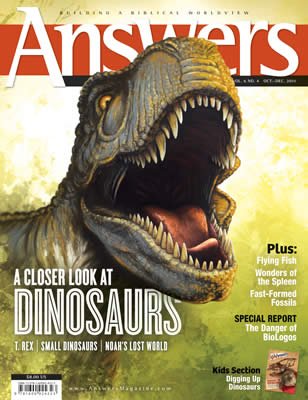Was Filet Mignon on Eden’s Menu?
Today many Christian leaders argue that the fossil record preceded Adam by millions of years. How does this view stack up against Scripture?
In an effort to squeeze millions of years into the Bible, many Christians today are turning on its head what the Bible teaches about Adam, the Garden of Eden, the first animals’ diet, and death’s entry into the world.
As more and more Christian leaders promote theistic (God-directed) evolution, believers need to understand the plain teaching of Scripture.
Origin of Death—Adam’s Sin
“The last enemy that will be destroyed is death” (1 Corinthians 15:26). To the average Christian, the Bible’s depiction of death seems pretty straightforward. Death is an “enemy.” In other words, it is an intrusion into this once-perfect world.
We take comfort knowing that in the future death will be “cast into the lake of fire” (Revelation 20:14). Also, God promises that one day “there shall be no more death, nor sorrow, nor crying. There shall be no more pain, for the former things have passed away” (Revelation 21:4).
That’s what we would expect from a good God who created a perfect world. At the end of the sixth day of creation, “God saw everything that He had made, and indeed it was very good.” (Genesis 1:31).
Yet we live in a world of life and death, joy and sorrow, love and hate—all at the same time. Only the history revealed in Genesis explains such a seemingly contradictory world.
What happened?
As a test of obedience, God commanded the first man, Adam, “Of the tree of the knowledge of good and evil you shall not eat, for in the day that you eat of it you shall surely die” (Genesis 2:17).
In the saddest day in the history of the universe, Eve ate of the fruit and gave it to her husband, who also ate (Genesis 3:6). As a result, “sin entered the world, and death through sin, and thus death spread to all men” (Romans 5:12).
Adam’s Death Was Physical—A “Return to Dust”
What is the nature of this “death”? In an attempt to downplay the historical account of Adam, many Christian leaders want to explain away the Bible’s first references to death.
But the Bible is clear. The death that entered the human race wasn’t only spiritual death (separation from God), but physical death.
In Genesis 2:7 we read where life came from: “The Lord God formed man of the dust of the ground, and breathed into his nostrils the breath of life; and man became a living being.” Then God’s judgment on sin took away that life: “In the sweat of your face you shall eat bread till you return to the ground, for out of it you were taken; for dust you are, and to dust you shall return” (Genesis 3:19).
This definition of death as a “return to dust” is confirmed in the New Testament: “The first man was of the earth, made of dust; . . . and we have borne the image of the man of dust” (1 Corinthians 15:47–49). Job also referred to death in this way: “And man would return to dust” (Job 34:15).
A minister once said to me, “I believe the dust referred to in Genesis 2:7 represents the animal [ape-like creature] God used to form man.” My response was, “Well, the Bible states we return to dust when we die, so what animal do we return to when we die?” No, when a human dies, that person’s body returns to dust.
Another church leader once said to me something like, “I believe dust-to-Adam represents molecules-to-man evolution.” I then replied, “Well, what does the Bible mean when it says Adam’s rib was ‘made into’ Eve [Genesis 2:21–22]?”
But what has this to do with filet mignon? Bear with me.
Adam and Eve Were Real, Flesh-and-Blood Humans
This fact of history—that the first woman was made from the man—is confirmed in the New Testament. For instance, “Man is not from woman, but woman from man” (1 Corinthians 11:8), and “woman came from man” (1 Corinthians 11:12).
In Genesis 2:23 Adam describes another specific detail about his wife’s physical existence: “This is now bone of my bones and flesh of my flesh; she shall be called Woman, because she was taken out of Man.”
Adam’s claim is confirmed in two New Testament passages. Quoting Genesis 2, Jesus concludes that all married couples “are no longer two but one flesh” (Matthew 19:5–6). Paul also quotes the Genesis account of Adam and Eve’s union in Ephesians 5:31.
Even Malachi 2:15 references Genesis 2 concerning Adam and Eve, who were “one” flesh: “Did He not make them one?”
What does all this have to do with filet mignon? Continue to bear with me, and it will become obvious soon.
The above is just a summary of Scripture verses to help substantiate that Genesis 1 and 2 are to be taken as literal history, established in other parts of God’s Word, especially the New Testament. Adam and Eve were the first two people—real people in history—and the Fall was a literal event.
Now, to Adam’s diet!
Original Diet—Vegetarian
God told Adam to eat of “every herb bearing seed” and fruit trees (Genesis 1:29). He was originally vegetarian.1
Some object that God doesn’t say he couldn’t eat animal flesh, but this objection is easily dealt with by God’s words to Noah after the Flood: “Every moving thing that lives shall be food for you. I have given you all things, even as the green herbs” (Genesis 9:3, italics added). We could paraphrase: “Just as I gave you the plants to eat, now I give you all things (everything).”
Adam didn’t eat filet mignon—nor did any of the animals on the earth until after sin.
This substantiates that Adam’s diet was vegetarian. Not until after the Flood did God allow humans to eat animals. So Adam certainly did not eat filet mignon before the Fall. And if Adam obeyed God, he did not eat filet mignon after the Fall.
But how do you respond to Christians who don’t believe that all this stuff about Adam’s diet applies to the animal world?
Genesis 1:30, written in the same way as Genesis 1:29, refers specifically to the animals: “Also, to every beast of the earth, to every bird of the air, and to everything that creeps on the earth, in which there is life, I have given every green herb for food” (Genesis 1:30).
Just as humans were vegetarian originally, the animals were also vegetarian. Before the Fall, animals didn’t eat animals, animals didn’t eat humans, and humans didn’t eat animals.
Yet the fossil record, which secularlists claim represents millions of years of earth’s history before the first man, includes examples of carnivory: bones from animals in the stomachs of other animals, fish swallowing fish, and teeth marks on bones. The fossil record also includes diseases, such as tumors and arthritis. The fossil record also contains thorns.
If animals were vegetarian before Adam’s sin, how could animals be killing animals for millions of years before Adam? If God declared His creation “very good” before Adam’s sin, how can it include cancer and other diseases? If thorns came after the Curse (after Adam’s sin, in Genesis 3:18), how could thorns exist already?
Romans 8:22, written in the context of the Fall’s effects, tells us, “We know that the whole creation groans and labors with birth pangs together until now.” There is no way a Christian can logically and consistently allow for millions of years of animal death, violence, and disease before Adam’s sin.
No, most of the fossil record is the graveyard of the Flood of Noah’s day. God created a perfect world, but the world we live in today—with all its disease, death, and violence—resulted from sin. It did not exist this way for millions of years.
Taking Genesis as literal history makes it obvious that animals and humans did not die until after Adam’s sin. Death is not “very good.” In fact, death is an “enemy.” Adam didn’t eat filet mignon—nor did any of the animals on earth until after sin.
Answers Magazine
October – December 2011
Answers magazine has decided to do some myth-busting. This issue will examine some of the most popular myths about the dinosaurs and how they died. Along the way, you’ll learn some other cool facts about these amazing creatures—quick, can you name the smallest kind of dinosaur? We will also examine some serious contemporary issues, such as the increase of biblical compromise in homeschool materials and the dangers of the new leader in “theistic evolution,” known as the BioLogos Foundation.
Browse IssueFootnotes
- Plants are not “living creatures”—they have no life spirit, or nephesh in Hebrew, as do animals and humans. So plants don’t “die” in the sense animals and humans do.
Recommended Resources

Answers in Genesis is an apologetics ministry, dedicated to helping Christians defend their faith and proclaim the good news of Jesus Christ.
- Customer Service 800.778.3390
- Available Monday–Friday | 9 AM–5 PM ET
- © 2025 Answers in Genesis







